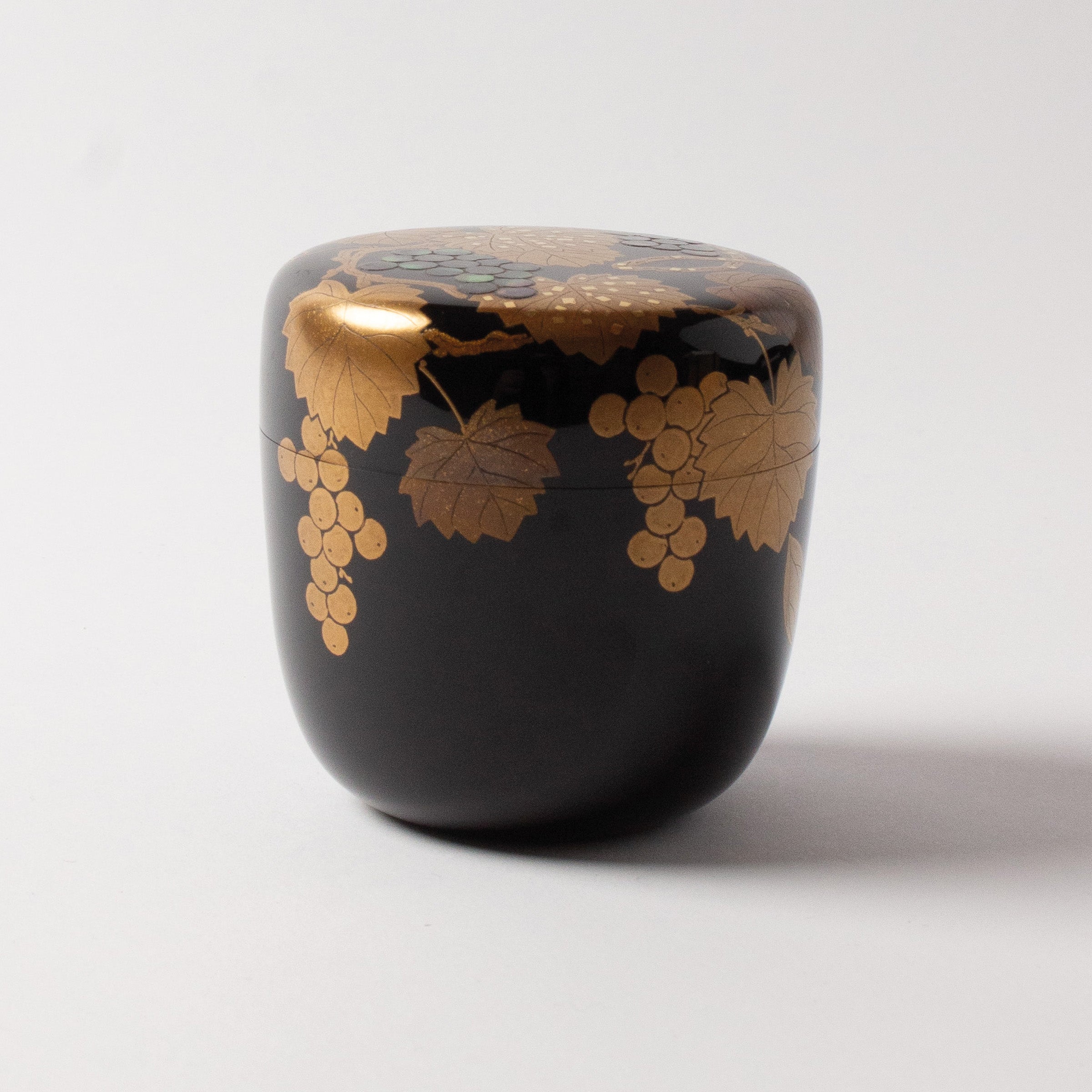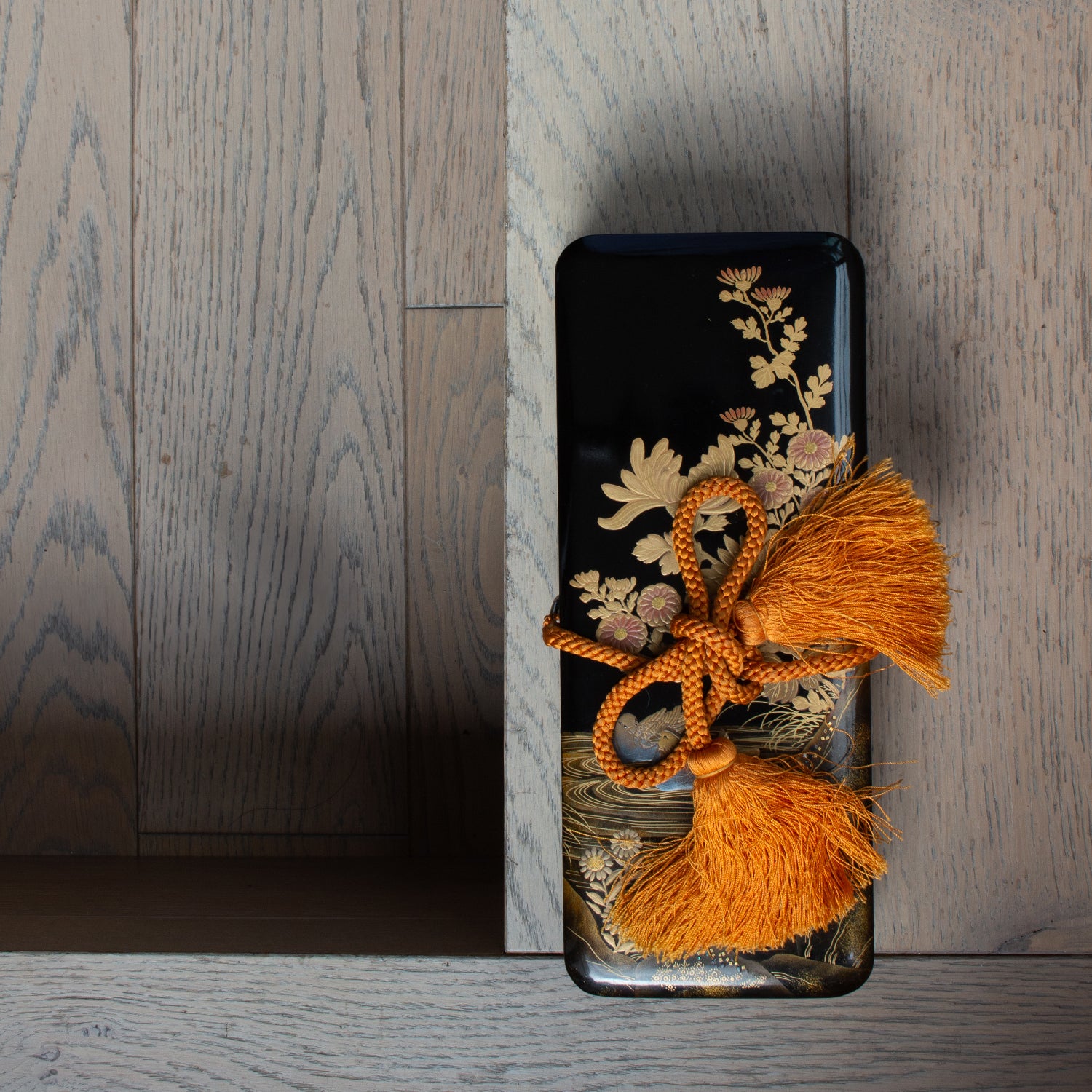











Natsume (tea caddy) lacquer and gold, budō (grape) motif by Ichigo Itchō
Magnificent piece of Ichigo Itchō (1998-1991), one of the most renowned masters of lacquer art, this natsume is handcrafted using traditional Wajima urushi lacquer techniques, with a very beautiful shiny black for the final layers, patiently applied to a very light turned wooden container on which a fabulous vine and grape decoration was then applied.
The gold powder maki-e decoration is done with great finesse and detail, between the veins of the vine leaves accentuated by inlays of small pieces of gold and some of the grapes made of mother-of-pearl (raden technique). Inside the lid two bees made of gold powder maki-e stand out against the black of the lacquer.
This natsume was made by the art craftsman Ichigo Itchō, a renowned lacquer master specializing in the art of maki-e, born in 1898 in Ishikawa Prefecture (Japan), and died in 1991. Residing in Wajima, he was recognized for his exceptional creations, notably natsume (tea boxes), and received numerous distinctions, including several selections at the prestigious Nitten salon.
This is a unique piece dating from the Shōwa era (1926-1989), accompanied by its protective box (tomobako) made of paulownia wood. on which is indicated the name of the craftsman with his official seal as well as the name of the work, and its braided sanadahimo cord. A white silk textile is also present, on which the seal and signature of the craftsman are affixed.
| PLACE OF MANUFACTURE | JAPAN |
| DIMENSIONS |
Diameter 7.3cm - Height 7cm. |
| WEIGHT | Natsume alone: 58gr; natsume + pouch + boxes: 187gr |
| MATERIALS | Wood, urushi lacquer, maki-e (gold powder), raden (lacquer) |
| STATE | In very good condition |
KNOW-HOW
Natsume (棗) are small boxes with few variations in shape and dimensions (which are codified), and which are made of Japanese urushi lacquer, welcoming the matcha tea powder during the traditional Japanese tea ceremony (chanoyu and sadō). They are magnificent objects that can be used for tea or superb decorative pieces to collect and to position individually or grouped on a pretty tray or in a display case. Modern productions are more often made of resin and not lacquer, and of molded wood powder or plastic. We only offer authentic traditional natsume in real Japanese urushi lacquer made according to the rules of the art. These objects are rare and precious, they are likely to increase in value. Read our article on natsume >
Traditional Japanese lacquer, urushi, comes from the sap of the lacquer tree (Rhus Verniciflua), which flows after incision of the bark. It is a very precious material, a tree will give a maximum of 200ml of sap in its life, which is worked by specialized craftsmen. It takes many operations, slow and meticulous, and several months of work to bring real lacquer objects to life. It is the oldest craft in Japan! Initially used to protect and waterproof objects, this immutable craft has become an art of extreme sophistication. If you want to know more about the art of Japanese lacquer, you can read our dedicated article > .
DELIVERY
Delivery
Free delivery in metropolitan France for purchases over €150. Orders are generally sent within 2 working days, except in special cases announced in the banner at the top of the site.
Precious items are wrapped in beautiful cloth, beautifully tied in the precious art of Korean pojagi. Some exceptions apply, especially if the items are bulky. Learn more >
Detailed information on deliveries is available via this link >
Your invoice will be sent by email
Payment methods
By card (Stripe operator): Visa, MasterCard, Discover, American Express.
Secure card payment with 3D Secure.
By PayPal, Apple Pay, Google Pay and Shop Pay
Returns and exchanges
14 days to change your mind.
CARE INSTRUCTIONS
Clean with a very soft cloth to avoid scratches, soaked in a little warm water if necessary (never soak your lacquer objects). No microwave, dishwasher, dryer. Do not expose to direct sunlight for a long time (risk of discoloration). If the atmosphere is very dry and very hot, and to avoid the risk of cracking, you can place a glass filled with water next to your lacquer object.
Choose options













The art of wrapping
The exceptional items are wrapped in a beautiful fabric beautifully knotted using the little-known art of Korean pojagi and decorated with a delightful maedup (Korean ornamental knot). Details and conditions >





